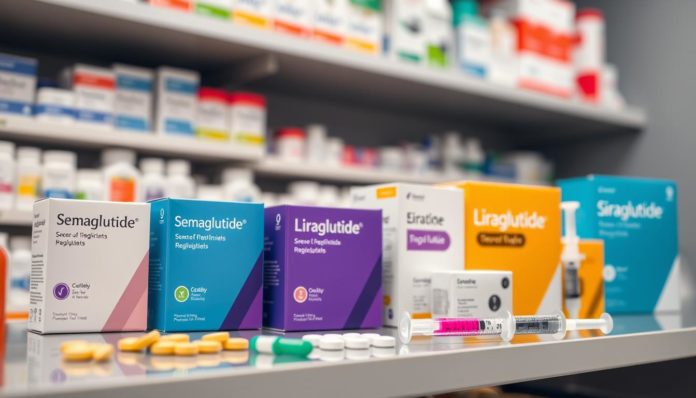Did you know over 88 million American adults have prediabetes? Shockingly, more than 84% of them are unaware of it. Semaglutide and Liraglutide have emerged as key players in diabetes treatment and weight loss. They are marketed under brands like Ozempic, Wegovy, and Victoza. These GLP-1 analogues are celebrated for their effectiveness against type 2 diabetes and their weight loss benefits.
Semaglutide and Liraglutide mimic the hormone glucagon-like peptide-1. They help with insulin release and reduce appetite. This leads to stable blood sugar levels and aids in weight loss. Their dual action offers new hope for those dealing with diabetes or obesity.
Join us as we explore the benefits of Semaglutide/Liraglutide. See how these medications are changing healthcare and bringing hope to many.
Introduction to Semaglutide and Liraglutide
Semaglutide and Liraglutide are important drugs known as GLP-1 agonists. They boost the body’s incretin response. This helps control insulin, which is vital for managing type 2 diabetes.

What are Semaglutide and Liraglutide?
Semaglutide and Liraglutide act like the GLP-1 hormone. They help the body produce more insulin when blood sugar is high. They also slow down digestion and decrease appetite. This leads to better blood sugar control and weight loss.
History of GLP-1 Agonists
The incretin concept began in the early 1900s. It set the stage for GLP-1 agonists. Over many years, experts learned how important GLP-1 is for managing glucose. This led to treatments that have changed diabetes care.
Mechanism of Action
GLP-1 agonists, such as Semaglutide and Liraglutide, imitate natural GLP-1 hormone effects. They attach to GLP-1 receptors, boosting insulin and lowering glucagon when sugar levels rise. They also slow digestion and help control hunger. This supports weight loss and better metabolism.
- Increased insulin secretion
- Reduced glucagon release
- Slowed gastric emptying
- Appetite regulation
Use of Semaglutide and Liraglutide in Diabetes Treatment
Semaglutide and Liraglutide are big players in diabetes care. They are great at controlling blood sugar. As GLP-1 agonists, they make diabetes treatment more effective.

Effectiveness in Blood Sugar Control
These drugs boost insulin release based on sugar levels. This reduces the risk of low blood sugar. So, your body only gets insulin when it needs it. This smart tactic improves diabetes handling.
Users of Semaglutide and Liraglutide see steadier blood sugar. This leads to fewer health issues and better wellness.
Comparison with Other Diabetes Medications
Unlike older medicines like metformin, these drugs balance well between working well and safety. They avoid issues like weight gain or severe low blood sugar. Plus, they often lead to weight loss.
This table highlights the key differences:
| Medication | Primary Mechanism | Main Benefits | Common Side Effects |
|---|---|---|---|
| Semaglutide | GLP-1 Agonist | Improved blood sugar control, weight loss | Nausea, gastrointestinal issues |
| Liraglutide | GLP-1 Agonist | Enhanced glycemic control, potential weight reduction | Nausea, vomiting |
| Metformin | Reduces glucose production | Lowers blood sugar, reduces hepatic glucose | GI disturbances |
| Sulfonylureas | Stimulates insulin release | Lowered blood sugar | Weight gain, hypoglycemia |
Thus, Semaglutide and Liraglutide not only improve blood sugar. They also have fewer side effects. This makes them a top choice for managing diabetes.
Weight Loss Benefits of Semaglutide and Liraglutide
Semaglutide and Liraglutide are not just for diabetes. They’re big news for losing weight. These meds help people manage obesity by cutting appetite and making them feel full longer.
How These Drugs Aid in Weight Loss
Both Semaglutide and Liraglutide act like GLP-1, a hormone. This hormone plays in areas of the brain that control hunger. Because of this, users feel less hungry and full longer. This helps a lot in losing weight.
Clinical Trial Results
In research, these drugs have proven to help shed pounds. Semaglutide helped participants drop up to 15% of their body weight. This makes it a top choice for fighting obesity.
Liraglutide also did well in studies. It has backed up its role in helping people lose weight.
| Drug | Average Weight Loss | Percentage of Participants Losing ≥ 5% Weight |
|---|---|---|
| Semaglutide | 15% | 75% |
| Liraglutide | 12% | 63% |
Cardiovascular Benefits of Semaglutide and Liraglutide
Semaglutide and Liraglutide are GLP-1 agonists that help improve heart health. Besides their use in diabetes, they’re good for the heart. They address key risk factors, aiding in preventing heart disease.
Impact on Heart Health
These medications are known to help the heart. They lower blood pressure and make cholesterol levels better. By doing so, they reduce the risk of heart problems, bolstering overall heart health.
Clinical Evidence Supporting Benefits
Research shows Semaglutide and Liraglutide cut down cardiovascular risks. Let’s look at some findings:
| Medication | Blood Pressure Reduction | Cholesterol Improvement | Cardiovascular Event Reduction |
|---|---|---|---|
| Semaglutide | 5-10 mmHg | 10-15% | 20% |
| Liraglutide | 5-7 mmHg | 8-12% | 18% |
These results show Semaglutide and Liraglutide are powerful for heart health. By including them in treatment, we can better prevent heart disease. Ongoing research will reveal even more benefits of these GLP-1 agonists.
Injectable Therapy: Administration and Practical Tips
To get the full benefits of injectable GLP-1 therapy, such as Semaglutide and Liraglutide, you need more than just the medicine. It’s also key to use the right injection method. And sticking to your dose schedule is a must.
How to Administer Semaglutide/Liraglutide
Using Semaglutide and Liraglutide the right way involves a few steps. Start by making sure your hands are clean. Next, change the injection spot each time, like moving from your belly to your thigh. This helps avoid any soreness.
When you inject, pinch your skin and aim the needle at a 90-degree angle. Pushing the plunger should be done gently to make sure all the medicine goes in.
- Wash hands thoroughly before handling the injection.
- Select a suitable injection site such as the abdomen or thigh, alternating sites each time.
- Pinch the skin and insert the needle at a 90-degree angle.
- Slowly depress the plunger to administer the dose completely.
- Dispose of the needle safely in a sharps container.
Storage and Handling Tips
Keeping your injectable GLP-1 therapy in the right condition is crucial for its success. These medicines need to be kept cold, but never frozen. When traveling, an insulated bag can keep your medicine at the right temperature. Always check the expiration date before use. Throw away any medicine that looks different in color or is cloudy.
- Keep the medication refrigerated but do not freeze it.
- Use an insulated bag for travel to maintain the medication’s required temperature.
- Check the expiration date regularly and dispose of any expired medication.
- Inspect the medication before use; do not use if discolored or cloudy.
Knowing how to give yourself these shots correctly and how to store them helps a lot. This makes sure you get the best results from your injectable GLP-1 therapy.
Side Effects and Safety Considerations
Semaglutide and Liraglutide are generally safe but be aware of potential side effects. They belong to the GLP-1 receptor agonists group and help manage Type 2 diabetes. Still, they might cause gastrointestinal issues.
Patients may feel nausea, vomiting, or diarrhea, mostly at the beginning of their treatment. Knowing these risks can help manage side effects better. Clinical studies show that these gastrointestinal effects can be controlled by adjusting doses and educating patients.
Semaglutide and Liraglutide can also lead to serious but rare side effects. These include acute pancreatitis and possible risks of pancreatic and thyroid cancers. Though these cases are uncommon, doctors should watch for early warning signs.
Closely monitoring the safety and efficacy of these medicationsand teaching patients to follow their doses can make a big difference in their treatment. It’s crucial for safe use and better management of side effects.
Understanding the risks of Semaglutide and Liraglutide is key to better patient care. For details on GLP-1 therapies, check here: https://www.ncbi.nlm.nih.gov/pmc/articles/PMC8294388/.
Dosage Guidelines and Dosing Instructions
When giving semaglutide and liraglutide, it’s critical to think about dosing guidelines. These guidelines are designed for each patient’s specific needs. This approach ensures people get the right dosage for their conditions, like diabetes or obesity.
Recommended Dosages for Different Conditions
For semaglutide, sold as Ozempic and Wegovy, dosing varies by its use. Ozempic, for diabetes, starts at 0.25 mg a week. It can go up to 2 mg. For weight loss, Wegovy starts the same but can increase to 2.4 mg weekly.
| Medication | Initial Dose | Maximum Dose |
|---|---|---|
| Ozempic | 0.25 mg/week | 2 mg/week |
| Wegovy | 0.25 mg/week | 2.4 mg/week |
| Liraglutide (Saxenda) | 0.6 mg/day | 3 mg/day |
Adjustments Based on Patient Needs
It’s crucial to personalize medicine when tweaking doses for semaglutide and liraglutide. The reason? Adjustments often hinge on how patients respond and tolerate the treatment, including any side effects. It’s vital to keep an eye on progress and adjust doses as required.
For detailed info on how to use and administer these medicines, check out the Mayo Clinic website.
Exploring Other Benefits of GLP-1 Agonists
GLP-1 agonists are not just for diabetes and obesity. They also help control appetite and make you feel full, leading to less eating.
Effects on Appetite and Satiety
One key effect of GLP-1 receptor effects is they make you feel more satisfied. Studies show that GLP-1 agonist users eat less. This is because these meds work on hormones that control hunger and fullness.
- Reduced hunger pangs
- Increased satiety after meals
- Decreased caloric intake
Potential Uses Beyond Diabetes and Obesity
GLP-1 agonists might also help with addictions, beyond their main use. They could offer new ways to treat:
- Alcohol addiction
- Nicotine dependence
- Opioid use disorder
More research could lead to GLP-1 agonists being a revolutionary treatment for these issues.
| Condition | Potential Benefit |
|---|---|
| Alcohol Addiction | Reduced craving and consumption |
| Nicotine Dependence | Lowered dependence and withdrawal symptoms |
| Opioid Use Disorder | Decreased usage and relapse rates |
Long-term Use and Sustainability of Results
Sticking with Semaglutide and Liraglutide for the long haul can really make a difference. These drugs do more than just provide quick fixes. They offer lasting health benefits, helping people manage chronic illnesses better.
Maintaining Weight Loss
A big perk of these medications is keeping weight off long-term. They’re not like quick-fix diets that only work for a while. Semaglutide and Liraglutide tackle the underlying metabolic problems. This means patients can keep losing weight for years, as long as they stick with the treatment.
Potential for Long-term Health Improvements
Using Semaglutide and Liraglutide over time can really boost your health, not just help you lose weight. They improve important health markers like blood sugar and heart health. Staying on these drugs can lower the chances of getting worse problems from diabetes and obesity. They’re key for managing chronic diseases.
Here’s some data to show how these drugs help with various health issues over time:
| Health Parameter | Initial | After 1 Year | After 2 Years |
|---|---|---|---|
| Weight (lbs) | 210 | 185 | 170 |
| HbA1c (%) | 8.0 | 6.5 | 6.2 |
| Cholesterol (mg/dL) | 220 | 190 | 180 |
Future Directions and Research in Semaglutide/Liraglutid Use
Researchers are now focusing more on Semaglutide and Liraglutide’s possible benefits. They are looking into their use for not just diabetes and obesity. Conditions like Alzheimer’s disease and non-alcoholic fatty liver disease are also being considered. This could widen their use in medicine.
There’s a push to make these drugs better and easier to use. Efforts to create oral versions are underway. This could get rid of the need for shots and help people stick with their treatment. Scientists are also studying the long-term effects of these therapies, such as lasting weight loss and heart benefits.
Scientists are digging into how Semaglutide and Liraglutide work at the molecular level. Understanding this could lead to better and more focused treatments. The future looks bright. These advances could greatly improve health care in the United States and elsewhere.
FAQ
What are Semaglutide and Liraglutide?
Semaglutide and Liraglutide are used for type 2 diabetes and weight loss. Semaglutide is also known as Ozempic and Wegovy. Liraglutide goes by Victoza.
What is the history of GLP-1 agonists?
GLP-1 agonists were first thought of in the early 1900s. Drugs like Semaglutide and Liraglutide work like the glucagon-like peptide-1 hormone.
How do Semaglutide and Liraglutide work?
They boost insulin when sugar is high and cut glucagon release. They also slow digestion and control appetite.
How effective are Semaglutide and Liraglutide in controlling blood sugar?
These medicines are great at lowering blood sugar. They bring new ways to treat diabetes.
How do Semaglutide and Liraglutide compare to other diabetes medications?
Semaglutide and Liraglutide balance well between working well and being safe. They are good for diabetes care.
How do Semaglutide and Liraglutide aid in weight loss?
They cut appetite and make you feel fuller. This helps people eat less and lose weight.
What do clinical trials say about the weight loss benefits of these medications?
Studies show Semaglutide can lower body weight by up to 15%. This is hopeful for obesity care.
What are the cardiovascular benefits of Semaglutide and Liraglutide?
They can lower blood pressure and cholesterol. This might cut down heart risks and boost heart health.
Is there clinical evidence supporting the cardiovascular benefits?
Yes, research has shown they reduce heart risks. They help in keeping the heart healthy.
How should Semaglutide and Liraglutide be administered?
They are given as shots under the skin. It’s important to use them right for the best results.
What are the tips for storing and handling these medications?
Keep them in the fridge and follow the package guide. This ensures they work well and are safe.
What are the potential side effects of Semaglutide and Liraglutide?
They can cause stomach issues. A rare risk is acute pancreatitis.
What are the recommended dosages for different conditions?
Dosage changes if used for diabetes or weight loss. Always follow your doctor’s advice.
Can dosages be adjusted based on patient needs?
Doses can change based on how a patient reacts. Treatment should be tailored to each person.
How do these drugs affect appetite and satiety?
Semaglutide and Liraglutide lower hunger and make you feel full. They are key in weight loss and may help with addiction.
Are there potential uses for GLP-1 agonists beyond diabetes and obesity?
Research suggests they might help with addiction and other disorders.
How can long-term use of Semaglutide and Liraglutide sustain results?
Long-term use can keep weight off and improve health. This helps in managing long-term conditions.
What is the future direction for research on Semaglutide and Liraglutide?
Research will look into more uses, understand long-term effects, and make drugs better and easier to use.


